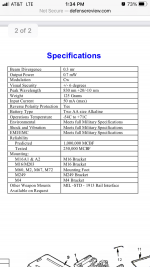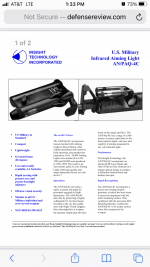Join the Hide community
Get access to live stream, lessons, the post exchange, and chat with other snipers.
Register
Download Gravity Ballistics
Get help to accurately calculate and scope your sniper rifle using real shooting data.

Install the app
How to install the app on iOS
Follow along with the video below to see how to install our site as a web app on your home screen.
Note: This feature may not be available in some browsers.
You are using an out of date browser. It may not display this or other websites correctly.
You should upgrade or use an alternative browser.
You should upgrade or use an alternative browser.
Night Vision When did military start using IR?
- Thread starter combat45acp
- Start date
The krauts used gen 0 in WW2 on a few panthers and rifles ... the USA seems to have sort of copied the german rifle solution for the Korean war ... but if OP means strickly when did the US military start using IR aiming lasers with Head mountable googles on small arms ... that is a more particular question ... I'm not sure what the first ground pounder googles were .. .the earlest ones I can find in my military manuals are the PVS-5 ...
https://en.wikipedia.org/wiki/AN/PVS-5
https://en.wikipedia.org/wiki/AN/PVS-5
Yeah I’m trying to figure out when we started using them for aiming small arms. I looked up history and get that NVG and IR are not “new” but the idea of a “leg” on the ground using one in combat kind of is. I had the pvs2/5/7 when I was in early 90’s and we did not have weapon mounted lasers on small arms. So I was curious as when it started being the norm.
... trying to figure out when we started using them for aiming small arms ...
Well as MarineePMI said, we started using night vision for aiming small arms in korea.
Here's the German version from WWII
And here's the US version from Korea ...
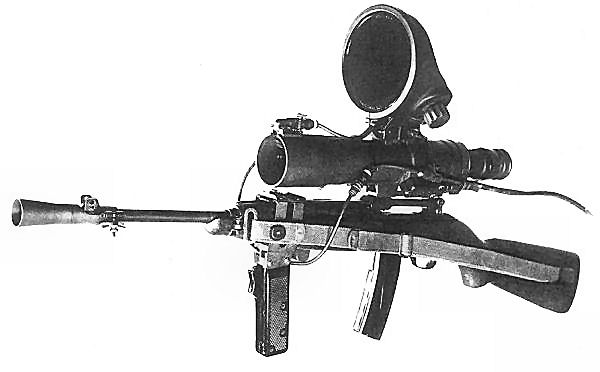
And I've seen a few folks refurbing the US units ... not sure I've seen any one claim to get one to work yet, but I've seen people trying.
We had A/N PVS-5 goggles in Ranger School in 1981 (one or two per squad). PVS-5s and the A/N PAQ-4 laser was SF issue in the late 80s (86-87).
The “norm” is what I’m looking for, maybe some younger guys who were infantry can chime in. I get Korean War, I’m trying to figure out when Laser/NVG started as a “thing”. We did not run lasers on any small arm weapons in early 90’s so maybe someone knows when it started to be “issued” or used more frequently.
Thanks.We had A/N PVS-5 goggles in Ranger School in 1981 (one or two per squad). PVS-5s and the A/N PAQ-4 laser was SF issue in the late 80s (86-87).
Knowing the exact question to start would help with a more exact answer sooner 
Seems like you're zeroing in on the question !
I've looked at all this before, but I admit I'm just googling refinding things I've looked at before.
The PAQ-4 manual I have is dated 1 April 1998 ... and applies to both the "B" and "C" models and is labeled as both and USMC TM and a US Army TM (different numbers of course ) it is intended to be a "operators" manual, which implies intended to be issued to "troops".
) it is intended to be a "operators" manual, which implies intended to be issued to "troops".
OOO ... it says it supercedes version 15 August 1996 !
Seems like you're zeroing in on the question !
I've looked at all this before, but I admit I'm just googling refinding things I've looked at before.
The PAQ-4 manual I have is dated 1 April 1998 ... and applies to both the "B" and "C" models and is labeled as both and USMC TM and a US Army TM (different numbers of course
OOO ... it says it supercedes version 15 August 1996 !
PVS-7 was coming in by 1990. By OIF in 2003 the PEQ-2 was starting to replace the PAQ-4 in Big, Ponderous Army.
Air force 1983 to 1987, we had 50's with night sights at that time,, but they were only really for tripod supported weapons. Or the APC's we used to patrol around out alert aircraft and weapons storage area.
We had goggles ,, they were kinda bulky but I scored a ride along with our rescue guys one in a helicopter and got to wear a pair since it was a night practice mission.. I dont recall ever seeing the goggles anywhere but attached to a helicopter. May have been a power issue..
I'd guess it was 1986...
We had goggles ,, they were kinda bulky but I scored a ride along with our rescue guys one in a helicopter and got to wear a pair since it was a night practice mission.. I dont recall ever seeing the goggles anywhere but attached to a helicopter. May have been a power issue..
I'd guess it was 1986...
There was the PAQ-4 aiming light (not the PAQ-4C laser) but like a narrow IR light beam that was around by at least the early 90's, possibly earlier.
First small arms use of IR was the Vampyr system the Nazi's had. It's a gen 1 setup. A huge battery backpack powered a huge IR lamp attached to an STG44 or whatever. This system was brought back to US and immediately reverse engineered so we had the same setup but attached to an M1 carbine. It wasn't very good and I doubt it saw much use. Better than nothing though.
Goddamn that would've sucked!
Stryker Bde.'s were pretty well equipped, especially the units that were reactivated --we got ALL new shit, even weapons. So in 2000/2001 we started out with PVS14's and PEQ2A (riflemen and grenadiers got PVS7D's and PAC4's). These were universally issued, everyone had NODs and a laser. But that shit got upgraded pretty fast too. Now they have the thermal overlay and PEQ15's or DBAL's.
When I was at Benning waiting on orders I pulled gate guard and worked with 3rd ID. Those guys didn't have shit! Sharing 7B's, and even if they DID get a laser, they'd have had to have mounted it with that funky barrel clamp. They had no rails, rifles worn silver. So I felt pretty lucky when I got to my unit and it was like fucking Christmas everytime gear got dropped off.
So it's really unit dependent. Some have bigger budgets or missions that rely on everyone being capable.
I'd say that Desert Storm was the first time widespread use of NV and IR lasers were deployed, mostly to squad and/or team leaders. I'd say Desert Storm 2 saw a more universal issue of these devices among line units.
We had A/N PVS-5 goggles in Ranger School in 1981 (one or two per squad). PVS-5s and the A/N PAQ-4 laser was SF issue in the late 80s (86-87).
Goddamn that would've sucked!
PVS-7 was coming in by 1990. By OIF in 2003 the PEQ-2 was starting to replace the PAQ-4 in Big, Ponderous Army.
Stryker Bde.'s were pretty well equipped, especially the units that were reactivated --we got ALL new shit, even weapons. So in 2000/2001 we started out with PVS14's and PEQ2A (riflemen and grenadiers got PVS7D's and PAC4's). These were universally issued, everyone had NODs and a laser. But that shit got upgraded pretty fast too. Now they have the thermal overlay and PEQ15's or DBAL's.
When I was at Benning waiting on orders I pulled gate guard and worked with 3rd ID. Those guys didn't have shit! Sharing 7B's, and even if they DID get a laser, they'd have had to have mounted it with that funky barrel clamp. They had no rails, rifles worn silver. So I felt pretty lucky when I got to my unit and it was like fucking Christmas everytime gear got dropped off.
So it's really unit dependent. Some have bigger budgets or missions that rely on everyone being capable.
I'd say that Desert Storm was the first time widespread use of NV and IR lasers were deployed, mostly to squad and/or team leaders. I'd say Desert Storm 2 saw a more universal issue of these devices among line units.
There was the PAQ-4 aiming light (not the PAQ-4C laser) but like a narrow light IR beam that was around by at least the early 90's, possibly earlier.
Yeah, PAC4 came out in late 80's I wanna say. I saw Delta or some group loading into a plane and they had 'em. This was 88 or 89 I'm guessing, possibly earlier though. Anyway, it's basically an eyesafe laser only. .7 or 1mW. The different models do different things, one pulses the laser like the PEQ2B (an item I've actually never seen, but hear they exist). They have an on and off switch and that's about it. No illuminator, no adjustment of beam.
But they'll still point out a target at 300m and if the rifle has a 300m zero, well, you get the idea.
I used a M3 in 1965 that was a Korean war hold over. Although better than nothing, the IR scope in the 113's an M60's(tank) were much better for viewing. Problem with them all was there was no depth perception at all. You could walk or drive off a cliff an never know it until to late. The PVS2 was light years ahead of the M3 with the 2nd gen PVS 4 another huge jump. The thing about the M3, was if you were a noise'y fuck moving, it an you were worthless as your movement noise, out ran the units ability real quick. A good set up was trail watching for most, but issued to a QM it had it's place. Many time's if not knowing/getting to the A/O before zero dark thirty, they were used by the best QM to get to the Ambush area, then fishing line strung behind would led the others quietly in. Once in place the LT would take it over to signal when to pop the bush. Fucking thing was heavy, hung on everything plus battery life was not long. When there was any moon/stars the bag on head trick worked/was much better if you had at least 2 or more guys that could/would work that trick.
First time I saw a handheld thermal was 2006 and it was next to worthless. Of course their were good vehicle thermal sights well before that.
During Desert Storm, the Airborne guys we were housed with had NV scopes on their SAW's.
Last edited:
First time I saw a handheld thermal was 2006 and it was next to worthless. Of course there were good vehicle thermal sights well before that.
We had thermal scopes for the 240's in 2002 I think, snipers got 'em around the same time (but you had to take the day scope off to use these). I can't recall the nomenclature, black hot/white hot, maybe 4x? 6x?, it was nice and we all got to play with it. It was new, so whatever it was would have been the best available at that time I'd imagine. I was out before they got issued the PSQ20's but they got those pretty quick too, the thermal/IR monocular.
We had thermal black hot/white hot for driving the Stryker and those had pretty good depth perception, a 7x thermal on the RWS gun mount along with a day camera that went up to 26x IIRC. Then the LRAS in the scout vehicle had a thermal/day cam that could read a license plate from miles away or even ID the driver. It was only limited by the curvature of the Earth. Badass piece of gear, it was big as fuck and took up a lot of room and had to be taken down to drive around. I understand they've made these a LOT smaller now.
To be perfectly honest, I couldn't tell the difference in performance between any of them. They all worked great. The LRAS is a different story, but it's also a $1million+ piece of surveillance gear.
During Desert Storm, the Airborne guys we were housed with had NV scopes on their SAW's.
We were given PEQ2's to put on the SAWs at night and had PVS14's. The problem with mounting anything on a SAW is the damn rail is on the feed tray cover like a 240. It moves around. A lot.
Last edited:
We had thermal scopes for the 240's in 2002 I think, snipers got 'em around the same time (but you had to take the day scope off to use these). I can't recall the nomenclature, black hot/white hot, maybe 4x? 6x?, it was nice and we all got to play with it. It was new, so whatever it was would have been the best available at that time I'd imagine. I was out before they got issued the PSQ20's but they got those pretty quick too, the thermal/IR monocular.
We had thermal black hot/white hot for driving the Stryker and those had pretty good depth perception, a 7x thermal on the RWS gun mount along with a day camera that went up to 26x IIRC. Then the LRAS in the scout vehicle had a thermal/day cam that could read a license plate from miles away or even ID the driver. It was only limited by the curvature of the Earth. Badass piece of gear, it was big as fuck and took up a lot of room and had to be taken down to drive around. I understand they've made these a LOT smaller now.
To be perfectly honest, I couldn't tell the difference in performance between any of them. They all worked great. The LRAS is a different story, but it's also a $1million+ piece of surveillance gear.
We were given PEQ2's to put on the SAWs at night and had PVS14's. The problem with mounting anything on a SAW is the damn rail is on the feed tray cover like a 240. It moves around. A lot.
Just a wee bit!
To the OP, if you can find David Fortier's article from Shotgun News several years ago was about the best history of NV out there. The Battle of Okinawa was basically the first time the US used a device in theater. A great read if you can find it I was honored to be part of the research. I'll see if I can dig up a electronic copy.
Just came across this post. Around 1990-91 I was stationed at Fort Ord CA with 1-9 Infantry. We were light Infantry and worked counter drug as part of JTF-6 (under Bush).
At the time we were told we were the first regular unit to employ the PAQ-2’s.
From what I recall the device mounted to the carry handle of the M16A2 an placed the device on the left front hand guard, later their was a front sight/barrel mount.
The device was a tube, about like the handle of a 2D Maglight without the head (PEQ-4 like). While the laser had range, it was effective out to a max of 100 meters. Their was a bore sighter that we used at night and the PAQ 2 would be spun in the barrel, while another soldier adjusted it to make a dot vs a circle.
We figured out the system rather well, but the issue was the offset mount and bore axis, combined with a beam that was a large cone.
At close range 25 meters you got a small dot, but had to hold over. At 100 M with a perfect zero, you had a 3-4” beam and would get about a 2-4” group when in the prone and braced. We learned to just zero for 75 meters and shoot unsupported center mass.
Later I was issued/used the PAQ-4C, PEQ-2, and PEQ-15, and each was much better.
At the time we were told we were the first regular unit to employ the PAQ-2’s.
From what I recall the device mounted to the carry handle of the M16A2 an placed the device on the left front hand guard, later their was a front sight/barrel mount.
The device was a tube, about like the handle of a 2D Maglight without the head (PEQ-4 like). While the laser had range, it was effective out to a max of 100 meters. Their was a bore sighter that we used at night and the PAQ 2 would be spun in the barrel, while another soldier adjusted it to make a dot vs a circle.
We figured out the system rather well, but the issue was the offset mount and bore axis, combined with a beam that was a large cone.
At close range 25 meters you got a small dot, but had to hold over. At 100 M with a perfect zero, you had a 3-4” beam and would get about a 2-4” group when in the prone and braced. We learned to just zero for 75 meters and shoot unsupported center mass.
Later I was issued/used the PAQ-4C, PEQ-2, and PEQ-15, and each was much better.
Meh, I'm channeling my inner Veer tonight...Yes, we were both wrong, I knew that word did not look right!!!
Thanks all, great reading. Makes me feel like i’ve taken them for granted. Every unit i’ve been in its a norm to have 100% with a pvs14, and a few psq-20s.
That is so freaking awesomeWell as MarineePMI said, we started using night vision for aiming small arms in korea.
Here's the German version from WWII

And here's the US version from Korea ...

And I've seen a few folks refurbing the US units ... not sure I've seen any one claim to get one to work yet, but I've seen people trying.
Americans and Germans developed night vision scopes around the same time toward the end of WWII, but never used them against each other. Germans used it briefly on the Eastern front and Americans first used it in 1945 in the battle for Okinawa. Reportedly, nearly half of Japanese casualties in that battle were due to the SniperscopeIR that American troops deployed there.
I wrote a short article on that for G&A's Retro issue in 2019. I should have the magazine here somewhere. If I find it, I'll scan it, but this is the magazine. The article is called "Own The Night".
ILya
I wrote a short article on that for G&A's Retro issue in 2019. I should have the magazine here somewhere. If I find it, I'll scan it, but this is the magazine. The article is called "Own The Night".
ILya
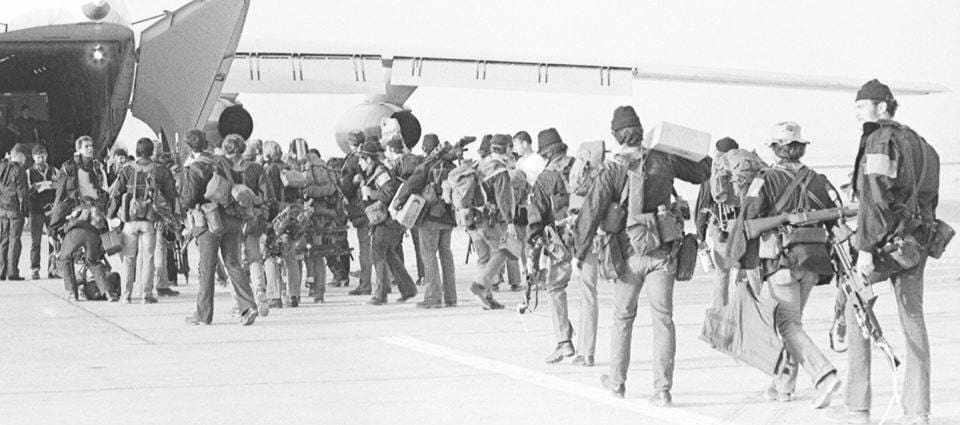
Last guy in line, AN/PAQ-4, 1980 Operation Eagle Claw, the earliest photograph I have seen that I can recall of an operationally used IR laser aiming device for an individual weapon.
During the Son Tay Raid in 1970 air elements had prototype night vision binoculars (probably immediate predecessors to the AN/PVS-5), however the ground elements only had weapon-mounted scopes, with the Singlepoints and overhead illum (which faded more quickly than expected) were the primary engagement method for carbines.
The AN/PAQ-4 and 4A were very different than the B & C (only real difference is that the B used a pulsed laser versus a constant-on like the C)--they were not rail-mounted (rails weren't really a thing when they were introduced in the early-1980s), they required specialized mounts designed for individual weapons, and were used on not just M16/CAR15s, but M60s and M249/Minimis. Other IR aiming lasers such as the Israeli AIM-1, which was originally designed for rotary wing weapons packages were also in use on carbines at this time, and by the early 1990s were relatively common with CT organizations--most of them had removable mounts, so they were only mounted for night missions, they did not remain on the weapons full time like most do now. The MK 23 OHWS program starting in ~1989-90 was always intended to be used ICW an IR aiming laser as well.
Going off of memory (I could have the dates slightly off as I'm not referencing anything as I type this) the AN/PVS-5 was formally adopted (again, this often means it was being tested prior) around 1972, while the AN/PAQ-4 was adopted ~1981. The AN/PVS-7 was adopted ~1982, and the AN/AVS-6 ANVIS in 1989. IIRC the AN/PAQ-4B/C are 1993 or 1994--too late to be fielded in Somalia as far as I can tell (AN/PAQ-4As and AIM-1s were used), but showing up soon thereafter, usually using the old barrel mount that attached forward of the FSB.
For crew served/belt fed weapons, weapon mounted optics like the M845 still generally remained the favored method for a good while longer, and even now "in general" weapon mounted thermals like the AN/PAS-13 TWS family are generally the favored firing solution, though IR lasers are frequently used as well.
~Augee
NVGs go back a ways. You question pertains to IR aiming with night vision. First time I saw IR coupled with small arms for aiming was 1998. PVS-14 and PAQ-4 although most of us drew the PVS-7s at the time. By 2001 we were standardized with PVS-14s, PAQ-4s and some PEQ-2's for crew served and leadership positions.
edit* posted then went back and read all the responses. TNVC-AUGEE gave excellent info and posted pic as proof. Obviously predates my personal experiences with IR and NVG.
edit* posted then went back and read all the responses. TNVC-AUGEE gave excellent info and posted pic as proof. Obviously predates my personal experiences with IR and NVG.
Last edited:
Colt R0723 (M16A2 Carbine) replica with AN/PAQ-4A (actual weapon was most likely a R653 M16A1 Carbine with AN/PAQ-4):



I've also got a set of "retro" AN/AVS-6(v)1s with the single sided IPD adjustment knob and 15MM eyepiece lenses with a warranty expiration date of 8/90, though it's got newer tubes in it.
Old night fighting guns and technologies are somewhat of a little side hobby of mine, when I have time for hobbies, hahaha
~Augee

I've also got a set of "retro" AN/AVS-6(v)1s with the single sided IPD adjustment knob and 15MM eyepiece lenses with a warranty expiration date of 8/90, though it's got newer tubes in it.
Old night fighting guns and technologies are somewhat of a little side hobby of mine, when I have time for hobbies, hahaha
~Augee
Those were probably the old TVS-2B's.Air force 1983 to 1987, we had 50's with night sights at that time,, but they were only really for tripod supported weapons. Or the APC's we used to patrol around out alert aircraft and weapons storage area.
We had goggles ,, they were kinda bulky but I scored a ride along with our rescue guys one in a helicopter and got to wear a pair since it was a night practice mission.. I dont recall ever seeing the goggles anywhere but attached to a helicopter. May have been a power issue..
I'd guess it was 1986...
FT Ord was awesome. I was never stationed there but I have been there. Wish they had never closed the place.Just came across this post. Around 1990-91 I was stationed at Fort Ord CA with 1-9 Infantry. We were light Infantry and worked counter drug as part of JTF-6 (under Bush).
At the time we were told we were the first regular unit to employ the PAQ-2’s.
From what I recall the device mounted to the carry handle of the M16A2 an placed the device on the left front hand guard, later their was a front sight/barrel mount.
The device was a tube, about like the handle of a 2D Maglight without the head (PEQ-4 like). While the laser had range, it was effective out to a max of 100 meters. Their was a bore sighter that we used at night and the PAQ 2 would be spun in the barrel, while another soldier adjusted it to make a dot vs a circle.
We figured out the system rather well, but the issue was the offset mount and bore axis, combined with a beam that was a large cone.
At close range 25 meters you got a small dot, but had to hold over. At 100 M with a perfect zero, you had a 3-4” beam and would get about a 2-4” group when in the prone and braced. We learned to just zero for 75 meters and shoot unsupported center mass.
Later I was issued/used the PAQ-4C, PEQ-2, and PEQ-15, and each was much better.
I played the Nor Cal HS golf finals on Black Horse there. Both it and Bayonet are great golf courses.FT Ord was awesome. I was never stationed there but I have been there. Wish they had never closed the place.
Thermal-wise, on the DMZ in Korea (1982-1984) we used the TOW and Dragon night sights for area surveillance, which were problematic in the winter when ambient temperatures dropped and affected the nitrogen-cooled systems. We also had a hand-held A/N PAS-7 which was not really user-friendly.
We were in the big leagues when the Army introduced the PAS-13.
We were in the big leagues when the Army introduced the PAS-13.
The Dragon and TOW sights sucked back in the day. More like blobs versus detail. I still remember the old Bradley (before the A3). Those thermals really sucked!! The new stuff is incredible.Thermal-wise, on the DMZ in Korea (1982-1984) we used the TOW and Dragon night sights for area surveillance, which were problematic in the winter when ambient temperatures dropped and affected the nitrogen-cooled systems. We also had a hand-held A/N PAS-7 which was not really user-friendly.
We were in the big leagues when the Army introduced the PAS-13.
Last edited:
Similar threads
- Replies
- 4
- Views
- 400
- Replies
- 13
- Views
- 1K
- Replies
- 23
- Views
- 3K
- Replies
- 1
- Views
- 262
